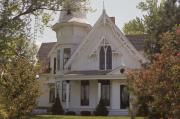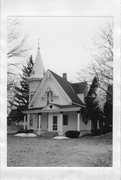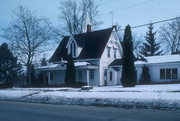Property Record
203 BRODHEAD ST
Architecture and History Inventory
| Historic Name: | Charlotte W. and John B. Stickney house |
|---|---|
| Other Name: | |
| Contributing: | |
| Reference Number: | 5480 |
| Location (Address): | 203 BRODHEAD ST |
|---|---|
| County: | Dane |
| City: | Mazomanie |
| Township/Village: | |
| Unincorporated Community: | |
| Town: | |
| Range: | |
| Direction: | |
| Section: | |
| Quarter Section: | |
| Quarter/Quarter Section: |
| Year Built: | 1857 |
|---|---|
| Additions: | 1882 |
| Survey Date: | 2000 |
| Historic Use: | house |
| Architectural Style: | Early Gothic Revival |
| Structural System: | Balloon Frame |
| Wall Material: | Board and Batten |
| Architect: | |
| Other Buildings On Site: | |
| Demolished?: | No |
| Demolished Date: |
| National/State Register Listing Name: | Not listed |
|---|---|
| National Register Listing Date: | |
| State Register Listing Date: |
| Additional Information: | A 'site file' exists for this property. It contains additional information such as correspondence, newspaper clippings, or historical information. It is a public record and may be viewed in person at the Wisconsin Historical Society, Division of Historic Preservation. ELABORATE BARGEBOARDS W/FINIALS AND WINDOW HOOD IN FRONT GABLE. POLYGONAL TOWER W/BRACKETED STEEP PAVILION ROOF. TRIANGULAR WINDOW IN TOWER. Stickney was a train agent and a Republican. A native of New Hampshire, John Stickney watched Mazomanie grow rapidly from a hamlet into a prosperous village. He arrived on the first train in 1856 and became the station agent for the Milwaukee and Mississippi Railroad (later part of the Chicago, Milwaukee, and St. Paul). He also served as the first president of the Village of Mazomanie from its incorporation in 1885 until 1891. Stickney's house, built overlooking the railroad, is a marvelous expression of Carpenter's Gothic architecture, a picturesque style so named because carpenters used lathes, scroll saws, and molding machines to create its elaborate Gothic Revival “gingerbread” details. Landscape architect A. J. Downing popularized the style for rural settings through pattern books he published in the mid-nineteenth century. Downing advocated vertical board-and-batten siding, used here in the Stickney House. But the Stickney House is most notable for its elaborate wooden decorations: lacy gingerbread bargeboards, an ornate gabled hood embellished by latticework and supported by scroll-sawn brackets, lancet-arched windows, and an octagonal turret added in 1882. Carpenter W. H. Whitney drew the plans, and carpenters Haseltine and Sutcliffe built the tower, decking it out with patterned shingles and triangular dormers. In 1904, the present classical porch, with its fluted Corinthian columns, replaced the original. Today the Stickney House is white, but bold polychromy--russet, blue, orange, yellow, and pink--originally enlivened the exterior. Many Victorian home owners painted their homes in adventurous color combinations, especially after manufacturers began advertising premixed paints in resealable cans. |
|---|---|
| Bibliographic References: | Mazomanie Landmarks, Mazomanie Historical Society, 1990, p. 21. Wisconsin State Journal, 10/2/1994, p. 2K. Buildings of Wisconsin manuscript. Prepared by Landscape Research, Ltd. for the Dane County Cultural Affairs Commission, Dane County: A Guide to the Rural Landscape, 1978. |
| Wisconsin Architecture and History Inventory, State Historic Preservation Office, Wisconsin Historical Society, Madison, Wisconsin |





